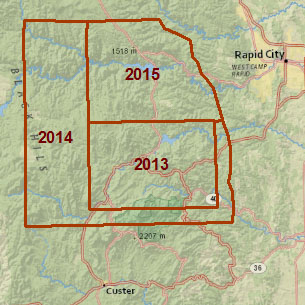Water Quality Studies

In 2013, we began a project to test the water quality of samples collected from private wells in order to provide a baseline of water quality in the metamorphic and igneous aquifers in the central Black Hills, and to identify areas where specific problems might be a concern. Testing is completely voluntary and confidential, and the results are provided only to our research team and to the homeowner. We choose wells to sample by sending our student research associates out to visit homes in targeted areas and to ask owners if they would like to participate. Water samples are collected immediately and taken to MidContinent Laboratories in Rapid City for testing. The cost of testing is covered by the project sponsor, the West Dakota Water Development District. To protect the privacy of the participating homeowners, well sampling locations are not plotted individually on any maps shown to the public. In addition to data from the private wells, we have also compiled published data from public wells to supplement our analysis.
Water Quality Tests
Water Quality Methodology
Water Quality Interactive Map
Arsenic Report Card
Hardness Report Card
Iron Report Card
Nitrate Report Card
Sulfate Report Card
Bacteria Report Card
The tests performed reflect constituents known to affect water quality in general or known to occur in the Black Hills. Click on the Report Card links to learn about the water quality test results for each constituent. For more information on how sampling was conducted and the data were analyzed, click here:
Water Quality Methodology. To explore relationships between water quality and geology in an interactive map, click here:
Water Quality Interactive Map.
Arsenic: Dissolved arsenic can occur in water due to natural weathering of certain minerals in rocks. The maximum contaminant level for arsenic in public water supplies is 0.010 mg/L. Arsenic is regulated in public water supplies because of links to cancer. It also can cause nerve damage and other problems.
View
Arsenic Report Card.
Calcium: Dissolved calcium normally is not a health hazard in water, but it contributes to hardness of water. No maximum contaminant level for calcium has been set by the State of South Dakota or by the U.S. Environmental Protection Agency.
Hardness: Hardness measures the quantity of dissolved minerals in water, particularly calcium and magnesium, which occur from dissolution as the water percolates through rock. Most people experience hardness in reference to the soap-consuming capacity of water. Hard water requires more soap to produce lather, can cause rings in bathtubs and sinks, and can also result in scale build-up in water lines and equipment. Water with a hardness greater than about 180 mg/L generally is considered hard water. Hardness is considered a nuisance but not a health hazard.
View
Hardness Report Card.
Iron: Dissolved iron in water affects the color and taste, and can cause rust-colored stains on plumbing fixtures and clothing. Problems with iron can occur with levels greater than about 0.3 mg/L. View
Iron Report Card.
Magnesium: Dissolved magnesium normally is not a health hazard in water, but it contributes to hardness of water. No maximum contaminant level for magnesium has been set by the State of South Dakota or by the U.S. Environmental Protection Agency.
Nitrate: Nitrate is a nitrogen-oxygen chemical unit that can combine with various organic and inorganic compounds. When taken into the body, nitrate is converted into nitrite. Nitrate occurs in the soil, animal excreta, crop residues, human wastes, some industrial wastes, and nitrogen fertilizers. It is soluble and moves with water. Excessive levels of nitrate in drinking water can cause serious illness in infants by interfering with the oxygen-carrying capacity of the child’s blood. Symptoms include shortness of breath and blueness of the skin. Nitrate also has the potential, after a lifetime of exposure, to cause dieresis, increased starchy deposits, and hemorrhaging of the spleen. The maximum contaminant level for nitrate in public water supplies is 10 mg/L.
View
Nitrate Report Card.
Sulfate: Water with a sulfate content greater than 250 mg/L can have a laxative effect and a bitter taste. Sulfate is considered a nuisance but not a health hazard. View
Sulfate Report Card.
Total coliform bacteria: This is not considered a health threat in itself but it indicates that other potentially harmful bacteria might be present. View
Bacteria Report Card.
Fecal coliform bacteria: This is considered an indication of contamination by fecal waste from humans or animals. View
Bacteria Report Card.